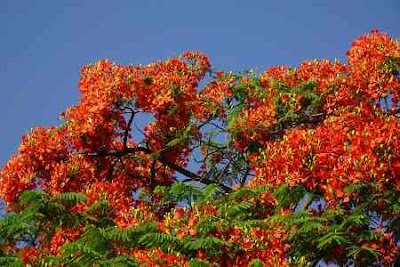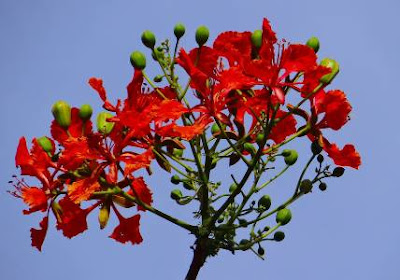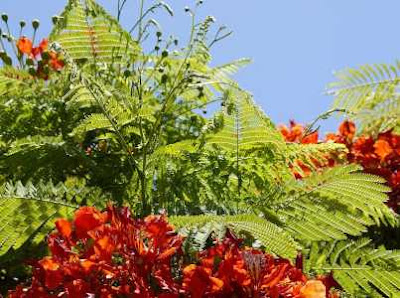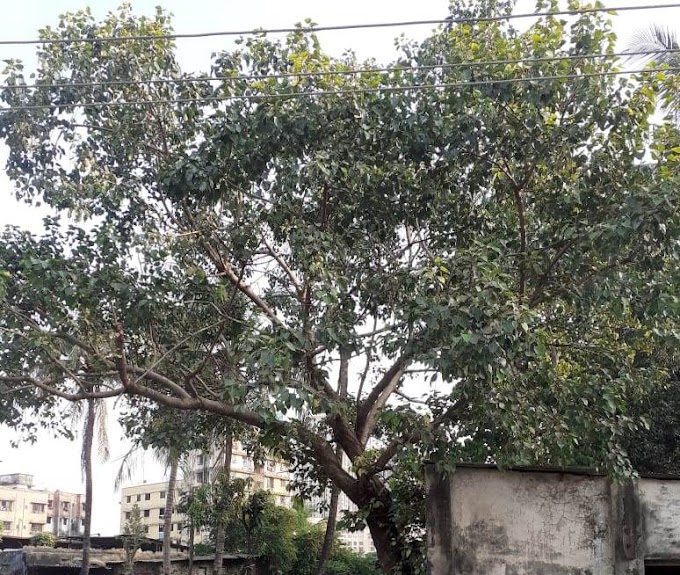Gulmohar tree
Gulmohar tree, Gulmohar meaning in English is Royal Poinciana or
Flamboyant. It is also called Gul Mohur, Flame tree, Peacock flower tree, Ornamental tree, Mayflower tree, etc. The scientific
name of Gulmohar is Delonix regia.
Gulmohar is a flowering plant native to Madagascar. It is a
legume or pea tree. A flamboyant display of red-orange flowers and their
fern-like leaves are noted over summer.
Gulmohar's charming hues and the color of the flowers
attract everyone. And hence this tree is considered one of the most beautiful
trees in the world.
It is said that in the sixteenth century the Portuguese saw
it in Madagascar. Countess de Poenshi was the governor of the French Cities.
In
the eighteenth century, this governer changed the name of Gulmohar to his name,
Poinciana. Later St. Kittis and Nevis approved it as their national flower.
"Flower of heaven", in fact, may be the correct name
of Gulmohar. And probably the most attractive name is given by french to
Gulmohar, in their language,
The leaves on the Gulmohar tree are nominal during the summer,
but the flowers are so much that it is difficult to count.
Gulmohar pods are green in color while the seeds are very
hard brown. When the winds blow, their voice sounds like a rattle, then it
seems as if someone is talking, that's why it has the name "woman's
tongue".
Gulmohar
is a drought and salt-tolerant, semi-deciduous tree. It is the best tree among
the quintessential trees for tropical landscapes. Coconut palm is the only
rival for its fame.
Gulmohar the tree is one of the world’s most colorful trees. It provides welcome shade and
spectacular color in the warm climate. Leaves are semi-deciduous and are
attractive, elegant, and fern-like.
Every
spring, or in blooming period tree produces clusters of long-lasting, orange-red
blooms. These blooms are with yellow, burgundy, or white markings. The length
of each boom is measured up to 5 inches across. displays five spoon-shaped
petals.
In many tropical and sub-tropical regions of the world, it
is grown as an ornamental tree. It is
found everywhere in the hot and humid places of India.
What is the meaning of the Gulmohar tree?
If we consider Gulmohar as a Parisian name. Then in
Parisian language, Gul means rose or flower, and Muhr means Seal or gold coin.
French has given Gulmohar the best name 'Royal Poinciana'.
Gulmohar tree is attractive and bold. Hence it is named 'Flamboyant' in
English.
Flamboyant means showy or bold in appearance and behavior. Delonix
Regia is the scientific name of it.
What is the other name of Gulmohar?
Since the local names are changed from place to place it
has given a scientific name as Delonix regia for global recognition.
 |
| Royal Poincianas |
Gulmohar is also called as or other names of Gulmohar are
Royal Poinciana, Flamboyant tree, Flame tree, Peacock flower tree, the flame of
the forest, Sein-Pann-ni (in Myanmar), Phượng vỹ", or phoenix's tail and
pupil's flower (in Vietnam).
It is also called Fire tree, Kempu Torai, Gold Mohar, Flame tree, Acacia Roja gold, Fuatausaga, Mayirkonri, Sakuranirow, Pilampwoia Weitahta, Gultora.
Meei Flower, Shima Sunkesula, Peddaturyl, Panjadi, Mayirkonri, Mayarum, Kattikayi, Gulimohur, Erraturyl, Doddartnagrandhi, ula, Flammenbaum.
pakai, sekoula, framboyan rojo, framboyn, rakau tamarumaru, puka kai, patai, marumaru, clavellino, uaruna, radha chura, krishna chura, tabuchan, morazan.
Malinche, josefina, guacamayo, guacamaya, flor de pavo, flor de fuego, flamboyant colorado, clavelino, arbol del fuego, royal poinciana, alasippu, etc.
It is also called Fire tree, Kempu Torai, Gold Mohar, Flame tree, Acacia Roja gold, Fuatausaga, Mayirkonri, Sakuranirow, Pilampwoia Weitahta, Gultora.
Meei Flower, Shima Sunkesula, Peddaturyl, Panjadi, Mayirkonri, Mayarum, Kattikayi, Gulimohur, Erraturyl, Doddartnagrandhi, ula, Flammenbaum.
pakai, sekoula, framboyan rojo, framboyn, rakau tamarumaru, puka kai, patai, marumaru, clavellino, uaruna, radha chura, krishna chura, tabuchan, morazan.
Malinche, josefina, guacamayo, guacamaya, flor de pavo, flor de fuego, flamboyant colorado, clavelino, arbol del fuego, royal poinciana, alasippu, etc.
Is Gulmohar an evergreen tree?
Within a week of the first flowering on the blooming
Gulmohar standing on dry hard land, the entire tree is filled with flowers like
dark red coals.
From spring to summer i.e. from March April to June July,
Gulmohar gives a feeling of coolness in the eyes of those who bear the
scorching heat covered with a sheet of red-orange flowers.
After this, the flowers begin to decrease, but by November
the flowers can be seen on the tree.
Gulmohar sheds its leaves in areas with a marked dry
season, during the drought, but in other areas, it is virtually evergreen.
Is Gulmohar native to India?
Gulmohar, a showy tropical tree or shrub is not native to
India. Gulmohar is endemic to Madagascar's dry deciduous forests.
It is native to Madagascar but has been introduced and
widely planted into tropical and sub-tropical regions worldwide for its immense
racemes of large scarlet orange flowers and long woody pods.
Indian history of Gulmohar
The history of Gulmohar in India is about two hundred years
old. 'Raj-Aabharana’ is its Sanskrit name. A tree decorated with royal
ornaments is the meaning of Raj-Aabharana.
This tree is also called 'Krishna Chood' because the Lord
Krishna statue’s crown is adorned with Gulmohar flowers.
This tree grew from Madagascar but now it is in a state of
extinction; Therefore, its original species has now been included in the list
of protected trees.
Within a week of the first flowering on the blooming
Gulmohar standing on dry hard land, the entire tree is filled with flowers like
dark red coals.
From spring to summer i.e. from March April to June July,
Gulmohar gives a feeling of coolness in the eyes of those who bear the
scorching heat covered with a sheet of red-orange flowers.
After this, the flowers begin to decrease, but by November
the flowers can be seen on the tree. Due to its similar feature, it is planted
in parks, gardens, and roadside.
Gulmohar Tree Description
 |
| Gulmohar Pod and Seeds |
These seeds are hard, glossy, oblong, and shaped very much like date seeds. In many places, it is also used for
fuel work.
Gulmohar Leaves: Leaves of Gulmohar are doubly pinnate or
compound leaves. They are characteristic light, bright green, and have a
feathery appearance.
The length of each leaf is around 30–50 cm with 20 to 40
pairs of primary pinnae or leaflets. Each leaf is divided into 10–20 pairs of
secondary pinnae or leaflets.
The pollen grains are elongated, approximately 52
microns in size.
Gulmohar Flowers: Gulmohar is a fragrant flower. The
flowers of Gulmohar are large in size. Four spreading orange-red petals or
scarlets are up to 8 cm long.
A fifth upright petal called the standard is
spotted with yellow and white and it is slightly larger. They appear at the
ends of branches in corymbs along.
Pods of the Gulmohar plant are green and flaccid when
young. Later they turn dark-brown and
woody. The length of pods can be up to 60 cm long and 5 cm wide.
Fruit
/ Pods: Gulmohar fruit or pods are oblong, legume,
stipulate, unilocular, and elongate. Pods or fruit is green and flaccid when
young. And when mature they turn to hard, dark brown, woody pods, ending in
short beaks.
After maturation pods split into 2 parts. The size of pods are approximately
3.8 cm thick, 30-75 cm long, and 5-7.6 cm broad.
 |
| Gulmohar flowers |
Within a week of the first flowering on the Gulmohar with
rooted branches standing on dry hard land, the entire tree is filled with
flowers like dark red coals. In addition to red, these flowers are also orange,
yellow in color.
Gulmohar tree has a
Madagascar's dry deciduous forest origin. It was endangered in the forest of
Madagascar. Then it has been introduced into tropical and sub-tropical regions
worldwide.
Now at present Gulmohar is widely cultivated elsewhere. And it is also regarded as naturalized in
many of the locations where it is grown.
Species of Gulmohar
- D. decaryi (Flamboyant Tree)
- D. decaryi (Flamboyant Tree)
- D. regia (Flamboyant)
- D. floribunda (Poinciana)
- D. leucantha (Poinciana)
- D. pumila (Poinciana)
- D. regia 'Kampong Yellow' (Flamboyant Tree)
- D. regia 'Smathers Gold' (Royal Poinciana)
- D. elata (White Gul Mohur)
Method of planting or cultivation of Gulmohar
The method of planting
or cultivation of Gulmohar is as follows. The seeds of Gulmohar are collected
and soaked in warm water.
The period of soaking can
be varying, but it should be soaked for at least 24 hours. Then these soaked
seeds are buried in warm, moist soil in a semi-shaded, sheltered position.
Instead of soaking, the
seeds can also be 'pinched' or 'nicked'.
(It can be done with small scissors or nail clipper) And then planted
immediately.
Moisture is penetrated
the tough outer casing and stimulates germination with these two methods. When
you plant seeds and the plant came out of it, then you do not have to tease that
plant at all. Do not touch that plant at all.
Until the seeds grow,
keep the seeds moist, that is, you have to pay attention to keeping the soil
wet regularly. Water has to be given regularly. Because its seeds are very
hard.
The plant should be kept in an indirect bright light location for 2-3 days. And after two to three days gradually move to a location that receives more than 6 hours of direct sunlight.
The plant should be kept in an indirect bright light location for 2-3 days. And after two to three days gradually move to a location that receives more than 6 hours of direct sunlight.
The seedlings grow
rapidly and within 3 to 4 weeks of planting the seeds in the soil, the plants
start coming out of the ground.
In an ideal condition, it
can be reached 30 cm in a few weeks. Gulmohar needs humidity and heat to grow,
but it develops well even where there is dry heat or a desert place.
Consistent moisture during the first growing season benefits the Gulmohar tree. During dry weather watering once or twice per week is appreciable. The Gulmohar tree also can be bonsai.
Consistent moisture during the first growing season benefits the Gulmohar tree. During dry weather watering once or twice per week is appreciable. The Gulmohar tree also can be bonsai.
Sunlight Requirement
Gulmohar is a strong tree It can withstand relatively heavy rainfall.
But still, it needs some moderate to heavy sunshine to germinate and start
growing.
So to plant Gulmohar we should choose a spot considering the above requirement. In ideal condition, it grows well.
So to plant Gulmohar we should choose a spot considering the above requirement. In ideal condition, it grows well.
Gulmohar Tree Care / Maintenance
Gulmohar plant can grow up to five feet per year and so matures and
develops pretty fast. It should be given some room to blossom and become a
pride of the garden.
In the early year’s branches tend to be weak. Hence to create a stronger
foundation Pruning should be used in the early years.
Pruning should be done carefully and regularly during the initial growth
stages as Maintenance. But serve pruning should be avoided for up to three
years. It will stop the blooming of the plant.
Gulmohar grows quite
well in summer. And as soon as winter comes, it drops all its leaves. Then only
these branches are visible. And again it starts going green in February.
 |
| Gulmohar Flower |
Fertilizer also can be
given to the Gulmohar plant but it does not need more fertilizer. So 25 days is
the right period to give fertilizer.
Care for the Gulmohar tree is limited to an annual feeding in spring. Well-established Gulmohar trees require very little supplemental irrigation. Use a complete fertilizer with a ratio such as 8-4-12 or 7-3-7.
In certain cases where you need to grow and flow the tree needs to be given more fertilizer to it.
Care for the Gulmohar tree is limited to an annual feeding in spring. Well-established Gulmohar trees require very little supplemental irrigation. Use a complete fertilizer with a ratio such as 8-4-12 or 7-3-7.
In certain cases where you need to grow and flow the tree needs to be given more fertilizer to it.
When you give
fertilizer to any tree, you have to follow this method. Make a pit of four and
4 inches, after that, put 1 kg fertilizer in this pit, after that fill the pit
with soil. In this way, fertilizer can be given in the tree.
Pests & Diseases
Gulmohar is a strong tree and
its plant is extremely resistant to most kinds of pesky pests. So pests won’t
be a problem.
If ever there are
insects in Gulmohar, mix 5 ml neem oil in water and spray it on the plant. In
this way, spray the mixture continuously for 2 days. This will kill insects.
Cutting method of Gulmohar cultivation
Semi-hardwood cutting
is another method of propagation of Gulmohar. This method is less common but it
is an effective method.
In this method, the
branches of the Gulmohar tree consisting of the current or last season's growth
can be cut into 30 cm sections. And then planted in a moist potting mixture.
Cuttings take a few
months to root. And hence this method is a slower method. Even this method is
slower than the seed propagation method but it is the preferred method for
ensuring new trees are true to form.
This cutting method is
a common method of propagation for the rarer yellow-flowering variety of the
Gulmohar tree.
Presence of Gulmohar around the globe
Gulmohar is of a Madagascar origin. But it is now widespread in most subtropical
and tropical areas of the world.
It is native to Madagascar and Zambia.
Gulmohar is exotic in Brazil, Jamaica, Nigeria, Puerto Rico, Singapore, South
Africa, Mexico, Niger.
Sri Lanka, Sudan Burkina Faso, Cyprus,
Ethiopia, India, Uganda, United States of America, Egypt, Eritrea, Kenya,
Tanzania.
Asia south
Royal Poinciana or
Flamboyant is planted in India. In India, it is named as Gulmohar. It is
referred to as the May-flower tree in India. It is called Gul mohr in West
Bengal, Bangalore, Odisha, and Sri Lanka.
This plant is also grown in Karachi,
Pakistan. Gulmohar is announcing the coming of the new year In Mauritius and La
Réunion.
Asia Southeast
Gulmohar is called as
Sein-Pann-ni in Myanmar. It is a sign of the Thingyan Festival (Apr 13 - 16/17)
in Myanmar. The time of flowering of Gullmohar in Myanmar is March in the south
and early to late April in the north. In Myanmar, it is planted in gardens and
as a roadside tree.
Gulmohar is an official
tree of Vietnam. It is grown in Thailand, the Philippines, and Vietnam. The
flowering of Gulmohar is the signal of the imminent arrival of the monsoon rains
in the Philippines.
In these countries, the
Gulmohar tree is called "Phượng vỹ", or phoenix's tail. In Vietnam,
it is a popular urban tree. The flowering season of Gulmohar is May–July in
Vietnam.
The same time is the end of the school year in
Vietnam. Due to this coincidence, the flower of Gulmohar is sometimes called
the "Pupil's flower". The city
Hải Phòng is nicknamed as "Thành phố Hoa phượng đỏ" ("City of
red Gulmohar").
Asia East
Gulmohar is also
cultivated in and grows in Southern China and Hong Kong. Gulmohar is an
official tree in Taiwan, Xiamen Fujian Province.
It is also an official tree
in Shantou, People's Republic of China
(PRC), and Canton Province. University located in Tainan, named as National
Cheng Kung University put Gulmohar or royal Poinciana on its emblem.
The Middle East and Europe
Gulmohar is planted in
Lebanon, Egypt, Israel, and Jordan. It is also planted in the Mediterranean
parts of Europe. It is also planted in North Africa, including the southern
coast of Spain, the Valencian coast, the Canary Islands.
Micronesia
Gulmohar is cultivated
and grows in Guam. In the Commonwealth of the Northern Mariana Islands Gulmohar
is the official tree.
Australia
Gulmohar is very widely
planted and grown in Northern Australia. In southern Australia, it was limited
to South East Queensland.
In the suburbs of Brisbane, it is a popular street
tree. Now in Sydney and other parts of New South Wales Gulmohar is grow and bloom
successfully.
Caribbean and Central America
Gulmohar can be found in The Bahamas, Nicaragua, Cuba,
Haiti, Belize, Cayman Islands, U.S. Virgin Islands, Jamaica, and Curacao.
You will find Gulmohar in Hawaii and Mexico, especially in
the Yucatan peninsula and Bermuda, and the town of Peñuelas.
 |
| Flame of the forest |
Gulmohar or flamboyant trees are found along the surrounding Río
Guyanese, Río Macana, and Río Tallaboa rivers. Hence it is nicknamed "El
Valle de Los Flamboyanes".
South America
Gulmohar is planted and grow throughout the whole of Brazil
such as Paraguay, Peru, etc
The blooming season of Gulmohar flowers
Gulmohar flowers blooming season is varies from country to
country or place to place. In southern Florida, it blooms in June, and in
Caribbean countries, between May and September.
In India and the Middle East, it flowers between April-June.
Its blooming season in Australia is December to February when it receives a
sufficient amount of heat.
It blooms between March and June on northern Mariana
Island.
Medicinal use of Gulmohar
Gulmohar flowers are as beautiful to look at, as are those
with curative properties. The flowers are sweet, pillar, nutritious, and soft.
Depending on the class of flowers, it is basically of two types - 1. Red
Gulmohar and 2.Yellow Gulmohar. Its medicinal properties are also
different depending on the color of the flowers.
Gulmohar flowers and legumes are sweet, enhancing the
desire to eat, are soft and nutritious. It is beneficial in general weakness,
thirst, diarrhea or diarrhea, blood loss, nose bleeding disease, white water,
Kamala or jaundice, anorexia, and diabetes.
 |
| Yellow Gulmohar |
Yellow Gulmohar is cool, balsamic, and reduces all three
defects. It is a lump, arthritis, and sinus destroyer.
The Seeds and the bark of Gulmohar are also of Ayurvedic
importance. Tribal people use their bark for headaches and digestion.
The bark of its stem helps blood clotting (the property of
stopping the blood coming out of injury) and the leaves with the properties of
detritus are cold, diuretics, inflammation-reducing properties, and
analgesics.
Gulmohar seeds have also been used in combination with
other herbs in some Ayurvedic medicines for diabetes. Gulmohar bark is also
used in malaria medicine.
Many such medicines are available in the market today, in
which some form of Gulmohar seed or bark has been added. Gulmohar flowers are
used to make Holi colors.
Madagascar island native Ornamental plant
Gulmohar is now present all over the world. Its timber, seed pods, seeds,
flowers all are beneficial. It has many medicinal properties such as
Anti-Inflammatory activity, Antidiabetic activity, Anti-diabetic activity, etc.
This tree has very good economic importance.
Economic Benefits of Gulmohar
Bee forage is produced by using
apiculture Flowers.
Gulmohar as Fuel
Pods and wood of Gulmohar are used for
fuel. The sapwood is light yellow and the heartwood is yellowish to light brown
in color.
Timber or wood of Gulmohar is heavy of
0.8 specific gravity approx. It is also coarse-grained, brittle, soft, and
weak. It takes a good polish and it is durable and resistant to water.
Resin or Gum From Gulmohar tree
Gulmohar tree yields water-soluble gum,
which is thick mucilage, reddish-brown or yellowish in form of warty tears. The
gum contains in seeds is used in the textile and food industries. Manufacturers
of tablets are using the gum obtained from the dried seeds as a binder.
Oil is known as the “Sangam” or “Karanga”
oil of commerce is obtained from the seeds. Gulmohar seeds contain 18 to 27.5 %
fatty oil. This oil is used in the tanning industry.







2 Comments
Thanks for the great content sir. I will also share this article with my friends & once again thanks a lots
ReplyDeleteThank you very much
Delete